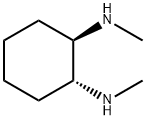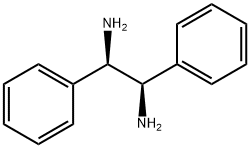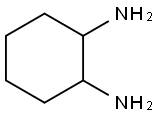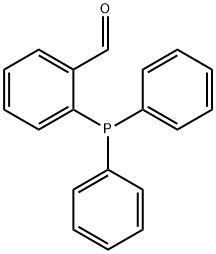(1R,2R)-(+)-1,2-DIAMINOCYCLOHEXANE-N,N'-BIS(2-DIPHENYLPHOSPHINO-1-NAPHTHOYL)
Synonym(s):(1R,2R)-(+)-1,2-Diaminocyclohexane-N,N′-bis(2-diphenylphosphino-1-naphthoyl)
- CAS NO.:174810-09-4
- Empirical Formula: C52H44N2O2P2
- Molecular Weight: 790.87
- MDL number: MFCD02684551
- SAFETY DATA SHEET (SDS)
- Update Date: 2025-07-16 09:55:24

What is (1R,2R)-(+)-1,2-DIAMINOCYCLOHEXANE-N,N'-BIS(2-DIPHENYLPHOSPHINO-1-NAPHTHOYL)?
Chemical properties
white to off-white powder
The Uses of (1R,2R)-(+)-1,2-DIAMINOCYCLOHEXANE-N,N'-BIS(2-DIPHENYLPHOSPHINO-1-NAPHTHOYL)
Properties of (1R,2R)-(+)-1,2-DIAMINOCYCLOHEXANE-N,N'-BIS(2-DIPHENYLPHOSPHINO-1-NAPHTHOYL)
| Melting point: | 224-231 °C |
| alpha | 69o (C=1 IN METHANOL) |
| pka | 13.43±0.40(Predicted) |
| form | Powder |
| color | off-white |
| optical activity | [α]20/D +69.0°, c = 1 in methanol |
| CAS DataBase Reference | 174810-09-4 |
Safety information for (1R,2R)-(+)-1,2-DIAMINOCYCLOHEXANE-N,N'-BIS(2-DIPHENYLPHOSPHINO-1-NAPHTHOYL)
| Signal word | Danger |
| Pictogram(s) |
 Corrosion Corrosives GHS05  Exclamation Mark Irritant GHS07  Health Hazard GHS08 |
| GHS Hazard Statements |
H302:Acute toxicity,oral H315:Skin corrosion/irritation H317:Sensitisation, Skin H318:Serious eye damage/eye irritation H361:Reproductive toxicity H370:Specific target organ toxicity, single exposure H372:Specific target organ toxicity, repeated exposure H402:Hazardous to the aquatic environment, acute hazard |
| Precautionary Statement Codes |
P201:Obtain special instructions before use. P202:Do not handle until all safety precautions have been read and understood. P260:Do not breathe dust/fume/gas/mist/vapours/spray. P264:Wash hands thoroughly after handling. P264:Wash skin thouroughly after handling. P270:Do not eat, drink or smoke when using this product. P272:Contaminated work clothing should not be allowed out of the workplace. P273:Avoid release to the environment. P280:Wear protective gloves/protective clothing/eye protection/face protection. P302+P352:IF ON SKIN: wash with plenty of soap and water. P333+P313:IF SKIN irritation or rash occurs: Get medical advice/attention. P405:Store locked up. |
Computed Descriptors for (1R,2R)-(+)-1,2-DIAMINOCYCLOHEXANE-N,N'-BIS(2-DIPHENYLPHOSPHINO-1-NAPHTHOYL)
| InChIKey | VXFKMKXTPXVEMU-AWSIMMLFSA-N |
New Products
Indole Methyl Resin tert-butyl 9-methoxy-3-azaspiro[5.5]undecane-3-carboxylate Boc-His(Boc)-OH 2-CTC Resin 4-Chloro-7-tosy1-7Hpyrrolo[2,3-d]pyrimidine 5,7-Dibromo-1H-indole 2,5-dichloro-N-hydroxy-4,6-dimethylpyridine-3-carboximidamide 2,2-Dimethoxy-7-azaspiro[3.5]nonane hydrochloride 4-chloromethyl-5-methyl-1,3-dioxol-2-one (DMDO-Cl) R-2-BENZYLOXY PROPIONIC ACID 1,1’-CARBONYLDIIMIDAZOLE 1,1’-CARBONYLDI (1,2-4 TRIAZOLE) N-METHYL INDAZOLE-3-CARBOXYLIC ACID 4-((2-hydroxyethyl)thio)benzoic acid 1-(TERT-BUTOXYCARBONYL)-2-PYRROLIDINONE Methyl 6-methylnicotinate 3-Pyridineacrylic acid tert-Butyl carbazate TETRAHYDRO-2H-PYRAN-3-OL 2-((4-morpholinophenylamino) (methylthio) methylene) malononitrile 3-(4-morpholinophenylamino)-5-amino-1H-pyrazole-4-carbonitrile 2,4-dihydroxybenzaldehyde 1,3-Diethyl-1,3-Diphenylurea Methyl 2-methylquinoline-6-carboxylateRelated products of tetrahydrofuran








You may like
-
 (R,R)-DACH-naphthyl Trost ligand CAS 174810-09-4View Details
(R,R)-DACH-naphthyl Trost ligand CAS 174810-09-4View Details
174810-09-4 -
 Pyridine 99.5% HPLC /UV SpectroscopyView Details
Pyridine 99.5% HPLC /UV SpectroscopyView Details
110-86-1 -
 Guanine , 99%View Details
Guanine , 99%View Details
73-40-5 -
 Piperazine Spot supply, best priceView Details
Piperazine Spot supply, best priceView Details
110-85-0 -
 Dibutyl PhthalateView Details
Dibutyl PhthalateView Details
84-74-2 -
 Imidazole Spot supply, competitive priceView Details
Imidazole Spot supply, competitive priceView Details
288-32-4 -
 Octadecyl 3-(3,5-di-tert-butyl-4-hydroxyphenyl)propionate 98% (GC)View Details
Octadecyl 3-(3,5-di-tert-butyl-4-hydroxyphenyl)propionate 98% (GC)View Details
2082-79-3 -
 Thiourea 99% ARView Details
Thiourea 99% ARView Details
62-56-6
Statement: All products displayed on this website are only used for non medical purposes such as industrial applications or scientific research, and cannot be used for clinical diagnosis or treatment of humans or animals. They are not medicinal or edible.
